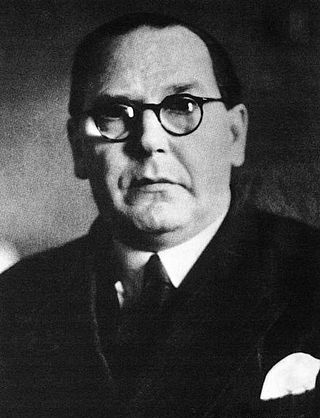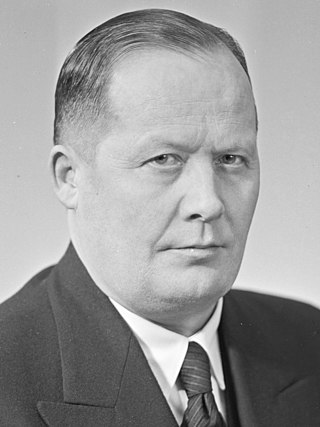
Juho Kusti Paasikivi was a Finnish politician who served as the seventh president of Finland from 1946 to 1956. Representing the Finnish Party until its dissolution in 1918 and then the National Coalition Party, he previously served as senator, member of parliament, envoy to Stockholm (1936–1939) and Moscow (1940–1941), and Prime Minister of Finland. He also held several other positions of trust, and was an influential figure in Finnish economics and politics for over fifty years.

The prime minister of Finland is the leader of the Finnish Government. The prime minister and their cabinet exercise executive authority in the state. The prime minister is formally ranked third in the protocol after the president of Finland and the speaker of the Parliament but is in practice the most powerful officeholder. Finland's first prime minister, Pehr Evind Svinhufvud, was appointed on 27 November 1917, just a few days before the country declared its independence.

The Lapua Movement was a radical Finnish nationalist, fascist, pro-German and anti-communist political movement founded in and named after the town of Lapua. Led by Vihtori Kosola, it turned towards far-right politics after its founding and was banned after a failed coup d'etat attempt in 1932. The movement's anti-communist activities continued in the parliamentarian Patriotic People's Movement.
A minister without portfolio is a government minister without specific responsibility as head of a government department. The sinecure is particularly common in countries ruled by coalition governments and a cabinet with decision-making authority wherein ministers without portfolio, while they may not head any particular offices or ministries, may still receive a ministerial salary and have the right to cast a vote in cabinet decisions. The office may also exist to give party leaders whose offices would not otherwise enable them to sit in Cabinet.

Karl-August Fagerholm was a Finnish politician. Fagerholm served as Speaker of Parliament and three times Prime Minister of Finland. Fagerholm became one of the leading politicians of the Social Democrats after the armistice in the Continuation War. As a Scandinavia-oriented Swedish-speaking Finn, he was believed to be more to the taste of the Soviet Union's leadership than his predecessor, Väinö Tanner. Fagerholm's postwar career was, however, marked by fierce opposition from both the Soviet Union and the Communist Party of Finland. He narrowly lost the presidential election to Urho Kekkonen in 1956.
A minister is a politician who heads a ministry, making and implementing decisions on policies in conjunction with the other ministers. In some jurisdictions the head of government is also a minister and is designated the 'prime minister', 'premier', 'chief minister', 'chancellor' or other title.

Finnish People's Democratic League was a Finnish political organisation with the aim of uniting those left of the Finnish Social Democratic Party. It was founded in 1944 as the anti-communist laws in Finland were repealed due to the demands of the Soviet Union, and lasted until 1990, when it merged into the newly formed Left Alliance. At its time, SKDL was one of the largest leftist parties in capitalist Europe, with its main member party, the Communist Party of Finland, being one of the largest communist parties west of the Iron Curtain. The SKDL enjoyed its greatest electoral success in the 1958 parliamentary election, when it gained a support of approximately 23 per cent and a representation of 50 MPs of 200 total, making it the largest party in the Eduskunta.

Finland competed at the 1960 Summer Olympics in Rome, Italy. 117 competitors, 107 men and 10 women, took part in 92 events in 14 sports.
Parliamentary elections were held in Finland on 1 and 2 July 1948.
Vilho Pekkala was a Finnish wrestler and Olympic medalist.

Mauno Pekkala was a Finnish statesman and politician who served as Prime Minister from 1946 to 1948. Mauno Pekkala was the brother of Eino Pekkala.
Salme Pekkala-Dutt was an Estonian-British communist politician, wife of Rajani Palme Dutt.

Ahti Antti Johannes Pekkala was a Finnish politician from the Centre Party.
Two-stage presidential elections were held in Finland in 1950, the first time the public had been involved in a presidential election since 1937 as three non-popular elections had taken place in 1940, 1943 and 1946. On 16 and 17 January the public elected presidential electors to an electoral college. They in turn elected the President. The result was a victory for Juho Kusti Paasikivi, who won on the first ballot. The turnout for the popular vote was 63.8%. President Paasikivi was at first reluctant to seek re-election, at least in regular presidential elections. He considered asking the Finnish Parliament to re-elect him through another emergency law. Former President Ståhlberg, who acted as his informal advisor, persuaded him to seek re-election through normal means when he bluntly told Paasikivi: "If the Finnish people would not bother to elect a President every six years, they truly would not deserve an independent and democratic republic." Paasikivi conducted a passive, "front-porch" style campaign, making few speeches. By contrast, the Agrarian presidential candidate, Urho Kekkonen, spoke in about 130 election meetings. The Communists claimed that Paasikivi had made mistakes in his foreign policy and had not truly pursued a peaceful and friendly foreign policy towards the Soviet Union. The Agrarians criticized Paasikivi more subtly and indirectly, referring to his advanced age, and speaking anecdotally about aged masters of farmhouses, who had not realized in time that they should have surrendered their houses' leadership to their sons. Kekkonen claimed that the incumbent Social Democratic minority government of Prime Minister K.A. Fagerholm had neglected the Finnish farmers and the unemployed. Kekkonen also championed a non-partisan democracy that would be neither a social democracy nor a people's democracy. The Communists hoped that their presidential candidate, former Prime Minister Mauno Pekkala, would draw votes away from the Social Democrats, because Pekkala was a former Social Democrat. The Agrarians lost over four per cent of their share of the vote compared to the 1948 parliamentary elections. This loss ensured Paasikivi's re-election. Otherwise Kekkonen could have been narrowly elected President - provided that all the Communist and People's Democratic presidential electors would also have voted for him.
Pekkala is a Finnish surname. Notable people with the surname include:
Janhunen is a Finnish surname. Notable people with the surname include:
Kaarle Pekkala was a Finnish sports shooter. He competed in the 50 metre pistol event at the 1960 Summer Olympics.

Eino Oskari Pekkala was a Finnish lawyer and politician. He was a member of the Parliament of Finland, representing the Socialist Electoral Organisation of Workers and Smallholders 1927–1930 and the Finnish People's Democratic League 1945–1948. In the 1920−1930s, Pekkala was twice in prison for his political activities, and he was even kidnapped by the fascist Lapua Movement in 1930. As the political situation in Finland changed after the World War II, Pekkala was the Minister of Education 1945–1946, and the Minister of Justice 1946–1948.

Mary Rhodes Moorhouse-Pekkala was a British-born Finnish patronage and civil rights activist, who was an heiress to a wealthy New Zealand-British family. In the early 1920s, she was active in the Communist Party of Great Britain and the Comintern. Moorhouse emigrated to Finland in 1928 after marrying the Finnish Socialist politician Eino Pekkala. She was one of the major financiers of the 1930s Finnish cultural left, and a prominent civil rights activist.

The Peasant March was a demonstration in Helsinki on 7 July 1930 by the far-right Lapua movement, attended by more than 12,000 supporters from all over the country. It was the most significant show of strength in the short history of the Lapua movement, aimed primarily at the Communists, but it was also intended to put pressure on the Finnish government. President Lauri Relander, Prime Minister Pehr Evind Svinhufvud, among others, were invited guests at the main event held at the Senate Square. In addition present were right-wing MPs, the country's military leadership, and General Mannerheim, commander-in-chief of the Civil War White Army. The peasant march was intentionally reminiscent of the White Victory Parade of 16 May 1918, and also followed its route.
























